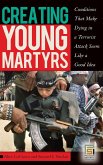
Gebundenes Buch
Conditions That Make Dying in a Terrorist Attack Seem Like a Good Idea
30. August 2008
Praeger
| eBook, PDF | 25,95 € |
Ähnliche Artikel

2,99 €
Sofort per Download lieferbar
eBook, ePUB
13. August 2023
ConnectAble Therapies Pty Ltd

0,99 €
inkl. MwSt. und vom Verlag festgesetzt.
Sofort per Download lieferbar

7,49 €
inkl. MwSt. und vom Verlag festgesetzt.
Sofort per Download lieferbar
eBook, ePUB
10. Mai 2024
Holly Starks

2,81 €
inkl. MwSt. und vom Verlag festgesetzt.
Sofort per Download lieferbar
eBook, ePUB
29. September 2015
S & P Productions,.Inc.

2,99 €
inkl. MwSt. und vom Verlag festgesetzt.
Sofort per Download lieferbar

2,99 €
inkl. MwSt. und vom Verlag festgesetzt.
Sofort per Download lieferbar
eBook, ePUB
31. August 2014
Technion Books

8,99 €
inkl. MwSt. und vom Verlag festgesetzt.
Sofort per Download lieferbar
eBook, ePUB
26. Februar 2008
Grand Central Publishing

1,99 €
inkl. MwSt. und vom Verlag festgesetzt.
Sofort per Download lieferbar
eBook, ePUB
28. November 2023
Virtued Press

4,99 €
inkl. MwSt. und vom Verlag festgesetzt.
Sofort per Download lieferbar
eBook, ePUB
23. September 2009
Holton

2,99 €
inkl. MwSt. und vom Verlag festgesetzt.
Sofort per Download lieferbar
eBook, ePUB
7. Januar 2023
Ben Nichols
Ähnlichkeitssuche: Fact®Finder von OMIKRON

